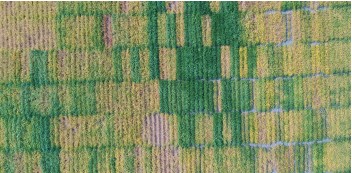Making Informed Decisions: Strip Trials Vs. Replicated Testing

If you’ve been to a Peterson Farms Seed Field Day or Cup of Agronomy event, you’ve probably heard us talk about the value of replicated testing and strip trials when it comes to decision making on the farm.

Strip trials, as seen above, are useful for a variety of reasons including product and treatment comparisons and site-specific performance.
Both strip trials and replicated testing have their place on the farm, but we need to ensure we’re using them the right way.
Strip trails are commonly used to compare products, treatments, hybrids and varieties. I’ve even seen them used to evaluate how much fungicide improves grain quality!
While there’s value in the observations we can make with strip trials, we need to be cautious about treating these observations as definitive. For example, in cases where a field is split between Treatment A and Treatment B, variations in soil type or field conditions can skew the results.
The other consideration is whether the comparison you are making is truly apples-to-apples. In a show plot, for example, it’s possible that not all of the entries have the same treatment. In a perfect world, everything would have the same treatment and be on a level playing field, but of course that’s not always the case.
Don’t get me wrong—strip trials provide valuable insights that replicated testing often cannot. They allow us to observe factors like product placement on different soil types, the performance of defensive hybrids and varieties, and even those “diamond in the rough” products that may not test well in controlled environments but thrive in specific geographies.
Take 2003E soybeans, for instance. This variety has never performed outstandingly in our replicated tests—mediocre, even. However, when placed on the right type of ground, it excels! Without strip trials, we might have overlooked this bean’s full potential.
That said, we must be cautious about basing product-selection decisions solely on strip trial yields. This is where replicated testing shines.

Our replicated research, as shown here, will show broader trends across a wide variety of soil types, moisture differences and disease susceptibility
By using multiple reps across different locations, we can be far more confident that the results we see are accurate and not skewed by variables like soil type, moisture or disease—factors that can significantly impact strip trial results. When you incorporate multiple years of replicated testing, it becomes even easier to identify trends and make informed decisions with confidence.
The takeaway? Don’t place too much faith in strip trials alone. They’re excellent for making observations, but when it comes to hard yield data, replicated testing is the gold standard
Key Management Strategies:
1. Strip trials offer valuable observations but have limitations. While strip trials help compare products, treatments, and hybrids, field variability can skew results, making them less reliable for final decision-making.
2. Replicated testing provides more reliable data. Multiple reps across different locations reduce variability and provide more accurate yield comparisons, helping farmers make data-driven decisions with greater confidence.
3. Both have their place in decision-making. Strip trials help identify site-specific performance, while replicated testing confirms broader trends, making a combination of both the best approach for selecting the right products.











